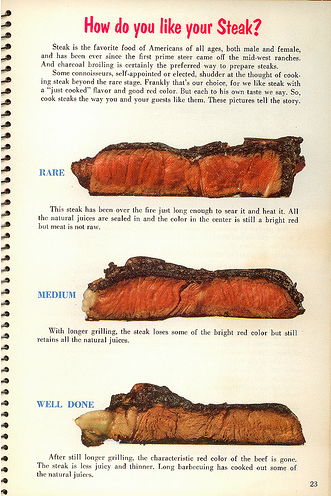
Editor’s Note: This is a guest post from AoM reader and friend Cameron Ming. Cameron is an award-winning barbequer and griller here in Oklahoma.
One of the closest links between man and beast is our love for meat. But what should separate us from mere animals is the manner in which that meat is cooked. Sadly, just because you’re human doesn’t mean you’re eating your meat any better than a beast.
Grilling a steak truly is like art: lots of people can draw, but not everyone is Michelangelo. Most of us will never make masterpieces at home, but getting close is much more simple than you think. Properly grilling a steak will separate you from the majority of the guys on the block and might even impress the ladies. But more important than showing up the fellas, you owe it to yourself to prepare the meat in the best way possible. It’s a matter of respect, I’d say.
Here are 5 simple tips to get you on track to painting your Meaty Sistine Chapel.
1. Choose your meat wisely. The meat is absolutely the most important part of the process. And knowing what cut you like will open your eyes to endless possibilities. Most people think the filet or tenderloin is the best cut. It is probably the most tender, but “best” is up for debate. Filets sacrifice flavor for tenderness and usually rely on some outside agent to give them a stronger flavor. Ribeyes have killer flavor but tend to be on the fatty side. The New York Strip falls somewhere in between.
So try different cuts to see what works for your taste. I love Ribeyes, but when I can’t shell out the cash, I’ll get a good chuck steak. It has good marbling (fat content), but has enough meat that I don’t feel like I’m wasting my time.
No matter which cut you favor, freshness is the key. If you have a little extra money, buy your meat at a true butcher’s shop. Chain stores like Walmart only carry “case-ready, pre-packaged” meat. This meat, sitting in styrofoam and covered in cellophane, is far less fresh than meat bought at a shop that actually cuts it themselves.
2. Let the flavor of the beef come through. Now matter how much make-up you put on an ugly woman, at the end of the day, she’s still ugly. By this I mean use only salt and peppe0r for seasoning. If you are using quality meat then you shouldn’t need anything else as a marinade. Minimalism is the key. Too many flavors and you mask the true beef flavor. This concept applies to BBQ and sauce as well.
Depending on the cut, I use a little olive oil, Kosher Salt, and fresh, coarse ground pepper. That’s really all you need.
3. Get the fire hot. Most prime steak restaurants have their grills going ridiculously hot — close to 1000°. Now, you probably won’t be able to get your home grill that hot, but you need to get it as hot as you possibly can. The more sear you can get on the meat, the more flavor you will lock in. The higher quality the meat, the more time you have before the meat really burns. It should just sizzle and sear, but keep an eye on it so you don’t lose your $30 steak to the flames.
4. Check the temp. There is nothing more destructive to a steak than overcooking it. A good steak should be cooked to medium rare (130° – 135° Fahrenheit, 55° – 60° Celsius). Anything over medium is pushing it. Cooking it to “well done” is a punishable crime in 39 states and basically ruins the steak.
With practice you can tell the “done-ness” of your steak by touch. But most of us aren’t that skilled. Get yourself a good meat thermometer. They are definitely worth the investment if you are doing a lot of cooking. For the regular guy, you can get a good thermometer for $6-$20 that will do just fine at keeping your meat “in the red.”
5. Let the meat rest. During the cooking process, the meat proteins constrict and essentially squeeze out their juices. Letting meat sit and rest after cooking partially reverses this process. If you let your steak rest for 5 minutes on a separate plate, the liquid should redistribute throughout the meat. It ends up retaining more flavor and will be juicier. Cover it with some tin foil to keep it warm.
6. Dig in. And pity your poor vegetarian friends.
Related Articles
- How to Grill the Perfect Burger
- Your Summer Grilling Secret: Using Wood Planks for Delicious Grilled Eats
- The Best Way to Salt Meat
- The Reverse Sear: The Best Cooking Method for Steak
- The Other Side of Grilling
Listen to my podcast with Pat LaFrieda about all things meat:


